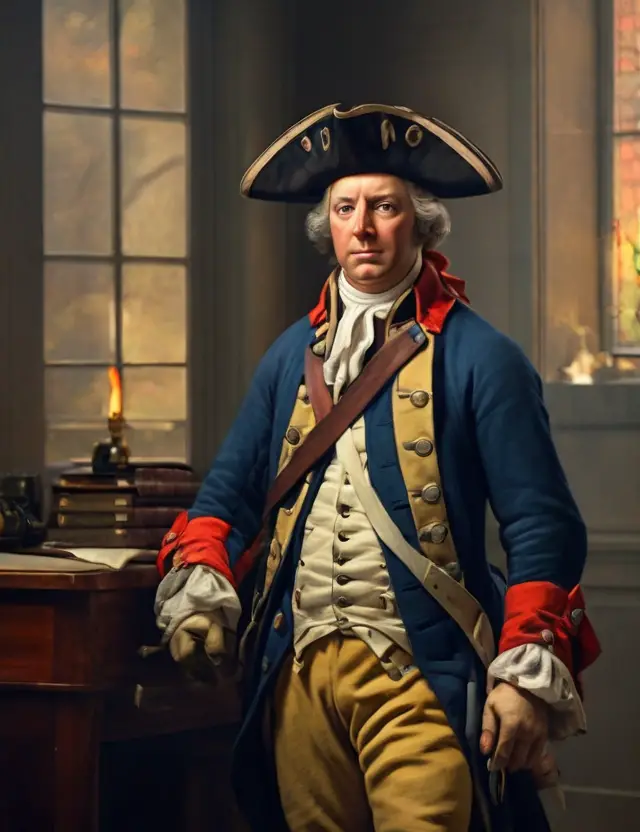
Born in 1737 in Braintree, Massachusetts, John Hancock emerged as a notable figure in the American Revolution, distinguished for his leadership, wealth, and political impact.
Raised in a family of merchants, Hancock’s journey unfolded from a merchant upbringing to a prosperous businessman, adept politician, and influential leader during the revolutionary period.
Early Life and Education
John Hancock’s early life and education laid the foundation for his later success.
Born to Mary Hawke and Reverend John Hancock, a Congregationalist minister, he faced early orphanhood.
However, his journey took a fortunate turn as he was taken in by his affluent uncle, Thomas Hancock.
Thomas, a prosperous merchant with a shipping business and a sizable estate in Boston, played a pivotal role in John’s upbringing.
Recognizing the importance of education, Thomas ensured that John received a top-notch education.
This began at the Boston Latin School and continued at Harvard College, where John graduated in 1754.
This solid educational background would prove instrumental in shaping John Hancock’s future endeavors and contributions to American history.
- Read also: Understanding the Effects of the Revolutionary War
- Read also: Unsung Heroes of the Revolutionary War
Leadership in the Boston Caucus
Post his college years, John Hancock entered his uncle’s shipping business, swiftly ascending to prominence within Boston’s political landscape.
Notably, he became an active participant in the Boston Caucus, a gathering of influential merchants and politicians committed to resisting British rule and advocating for colonial rights.
Hancock’s political trajectory gained momentum when he secured a position in the Massachusetts House of Representatives in 1766.
In this role, he emerged as a vocal opponent of both the Stamp Act and the Townshend Acts, pivotal legislations that imposed taxes on the colonies.
His involvement in these critical political circles marked the beginning of Hancock’s leadership in the resistance against British taxation policies, setting the stage for his future contributions to the revolutionary cause.

Presidency of the Second Continental Congress
In the pivotal year of 1775, John Hancock assumed the presidency of the Second Continental Congress, a central authority charged with the oversight of the American Revolution.
His leadership during this crucial period played a vital role in shaping the trajectory of the burgeoning nation.
Notably, Hancock presided over the Congress during significant milestones, including the historic moment of drafting the Declaration of Independence.
Hancock’s role went beyond mere governance; his presence became iconic, especially with his bold signature gracing the Declaration of Independence.
His distinctive and prominent signature has since evolved into a symbol synonymous with American independence, embodying the spirit and commitment of the revolutionary leaders during a defining chapter in U.S. history.
Signing the Declaration of Independence
When John Hancock affixed his signature to the Declaration of Independence, it went beyond a mere formality – it stood as a resolute declaration of his unwavering commitment to the cause of American independence.
This act wasn’t without consequence; it boldly placed Hancock’s life and fortune in jeopardy, as he became a wanted figure in the eyes of British authorities.
Faced with the imminent threat, Hancock took refuge in hiding for a period.
Despite the risks, he eventually reemerged in Boston, undeterred and steadfast in his dedication to leading the revolutionary cause.
Hancock’s signature on the Declaration became a tangible manifestation of the sacrifices made by those who dared to defy British rule, solidifying his role as a stalwart patriot in the fight for American independence.
Was John Hancock captured by the British?
Contrary to a widely circulated myth, John Hancock was not captured by the British during the American Revolution.
Despite being a wanted figure, there is no historical evidence supporting his capture by British forces. Instead, in 1775, when the British occupied Boston, Hancock wisely chose to flee the city to avoid capture.
Hancock’s decision to leave Boston proved prudent, allowing him to evade British pursuit during the occupation.
It wasn’t until 1776, after the British had evacuated the city, that Hancock returned to Boston.
This clarification dispels the misconception surrounding Hancock’s capture and highlights his strategic moves to navigate the challenging circumstances of the American Revolution.

Legacy
John Hancock’s legacy is indelibly marked by his exemplary leadership, unwavering courage, and wholehearted commitment to the cause of American independence.
Despite his wealth, Hancock chose a path far from complacency.
Instead, he ventured into the realm of politics, embracing a radical stance against British rule that went beyond mere rhetoric.
Hancock’s legacy is encapsulated in his daring decision to risk everything for the pursuit of a free and independent America.
His pivotal role, notably reflected in his signature on the Declaration of Independence, stands as a powerful testament to his resolute dedication to the cause.
Beyond financial prosperity, Hancock’s enduring legacy echoes the values of sacrifice, determination, and a profound belief in the principles that would shape the foundation of the United States.
- Read also: Civil War vs Revolutionary War
- Read also: Feudalism In Medieval Societies
Conclusion
At the heart of the American Revolution, John Hancock emerges as a pivotal figure renowned for his leadership, affluence, and political sway.
His influential role extended to the drafting and signing of the Declaration of Independence, where his distinctive and bold signature has evolved into an enduring symbol of American autonomy.
Exploring the intricacies of his life and legacy provides a profound insight into the sacrifices and challenges that paved the way for the birth of our nation.
FAQs
John Hancock is best known for his bold signature on the Declaration of Independence, but he was also a successful businessman, politician, and revolutionary leader.
No, John Hancock was never captured by the British during the American Revolution. While he was a wanted man, he was able to evade capture and continue to lead the revolutionary cause.
John Hancock’s legacy is one of leadership, courage, and commitment to the cause of American independence. He risked everything for a life of politics and radical opposition to the British, and his signature on the Declaration of Independence is a testament to his commitment to the cause of American independence.


